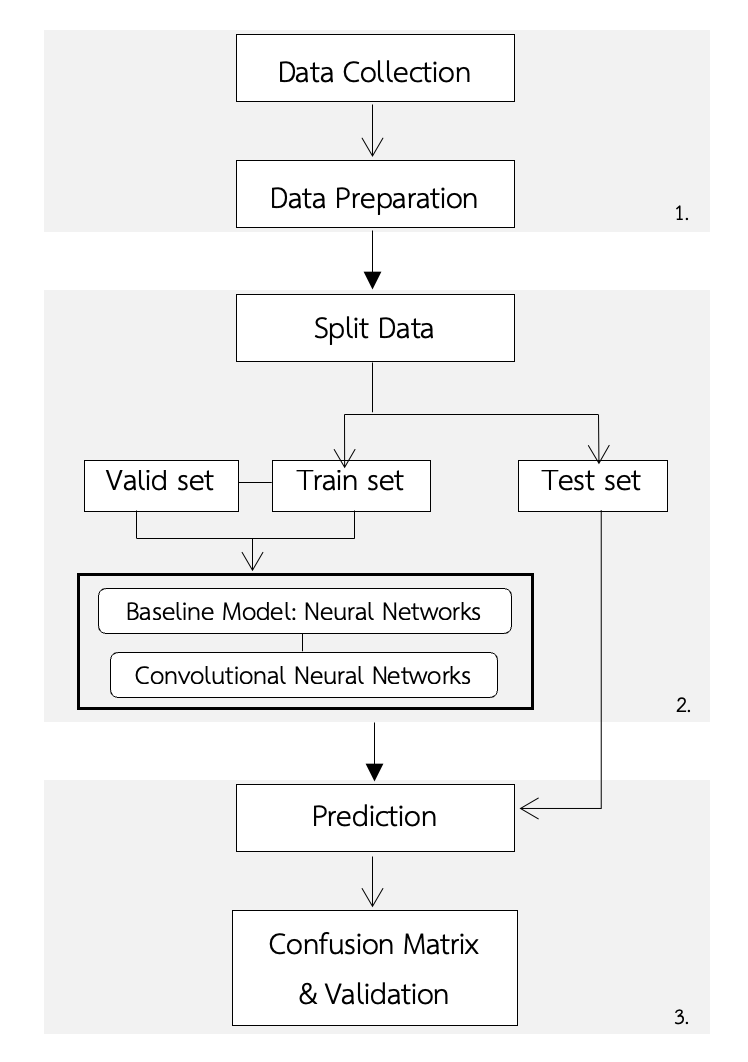Classification of Nail Abnormalities using Convolutional Neural Network
Main Article Content
Abstract
Nails are one organ which can indicate the status of a health condition through its own appearance. To create a model which can be applied as a tool for self-classifying nail abnormalities, this article presents the study and analysis on seven abnormalities of nails: 1) Beau's lines on Nails, 2) Black line on Nails, 3) Nails Clubbing, 4) Muehrcke’s nails, 5) Onycholysis, 6) Terry’s nail, and 7) White spots on Nails. The data is composed of seven hundred images compiled from Google images. They are separated into training sets, validation sets, and test sets and arranged into a 64:16:20 ratio, respectively. The Convolutional Neural Network (CNN) model method was developed from the Artificial Neural Network (ANN) model. It points out that CNN achieves 81.43% accuracy, which is more efficient in classifying nail abnormalities than ANN, which only has 43.57% accuracy.
Article Details

This work is licensed under a Creative Commons Attribution-NonCommercial-NoDerivatives 4.0 International License.
All authors need to complete copyright transfer to Journal of Applied Informatics and Technology prior to publication. For more details click this link: https://ph01.tci-thaijo.org/index.php/jait/copyrightlicense
References
ชนิดา ฉันทวนิชย์. (2558). การวิจัยและพัฒนาผลิตภัณฑ์เคลือบเล็บชนิดลอกออกได้. เชียงราย: มหาวิทยาลัยแม่ฟ้าหลวง.
ณัฐวุฒิ ศรีวิบูลย์. (2563). การปรับปรุงประสิทธิภาพการจำแนกภาพเอกซเรย์ทรวงอกด้วยโครงข่ายประสาทเทียมแบบสังวัตนาการโดยใช้เทคนิคการเพิ่มภาพสำหรับวินิจฉัยโรคโควิด-19. กาฬสินธุ์: มหาวิทยาลัยกาฬสินธุ์.
ณัฐโชติ พรหมฤทธิ์. (2564). Fundamental of DEEP LEARNING in Practice. (พิมพ์ครั้งที่ 1). กรุงเทพฯ: สำนักพิมพ์อินโฟเพรส.
พิมพา ชีวาประกอบกิจ. (2562). การปรับปรุงประสิทธิภาพในการจำแนกภาพด้วยโครงข่ายประสาทแบบคอนโวลูชันโดยใช้เทคนิคการเพิ่มภาพ. สระบุรี: มหาวิทยาลัยนานาชาติเอเชีย-แปซิฟิก.
วิชชุดา ธงกิ่ง, ภูษิต มิตรสมหวัง, บุระ สินธุภากร และเจษฎา ตัณฑนุช. (2565). การวิเคราะห์และการจำแนกกระดูกสันหลังที่ผิดปรกติด้วยขั้นตอนวิธีโครงข่ายประสาทสังวัฒนาการ. วารสารเทคโนโลยีสุรนารี, 16(1), 1-13. https://doi.org/10.14456/jait.2023.2
ศิรชัย โชติชาติมาลา และนุวีย์ วิวัฒนวัฒนา. (2563). แบบจำลองการคัดแยกผลไม้แบบหนึ่งชนิดด้วยการเรียนรู้ของเครื่องเพื่อตรวจจับรูปแอปเปิ้ล. กรุงเทพฯ: มหาวิทยาลัยศรีนครินทรวิโรฒ.
อุมาภรณ์ สายแสงจันทร์, รพีพร ช่ำชอง และอรรถพล สุวรรณษา. (2565). การเปรียบเทียบวิธีการวิเคราะห์โรคใบมะนาวด้วยการเรียนรู้เชิงลึก. วารสารวิทยาการสารสนเทศและเทคโนโลยีประยุกต์, 4(1), 71-86.
https://ph01.tci-thaijo.org/index.php/jait/article/view/248021
Alirezanejad, M., Saffari, V., Amirgholipour, S., & Sharifi, A. M. (2014). Effect of locations of using high boost filtering on the watermark recovery in spatial domain watermarking. Indian Journal of Science and Technology, 7(4), 517–524.
https://doi.org/10.17485/ijst/2014/v7i4.12
Brownlee, J. (2019). Deep learning for computer vision. Retrieved 23 May 2022. Retrieved from https://machinelearningmastery.com/how-to-configure-image-data-augmentation-when-training-deep-learning-neural-networks/
Fawcett, R. S., Thomas, M., & Daniel, L. (2004). Nail abnormalities: Clues to systemic disease. American Family Physician, 69(6), 1417-1424.
https://www.aafp.org/pubs/afp/issues/2004/0315/p1417.html
Nasritha, K., Kerdprasop, K., & Kerdprasop, N. (2018). Comparison of sampling techniques for imbalanced data classification. Journal of Applied Informatics and Technology, 1(1), 20–37. https://ph01.tci-thaijo.org/index.php/jait/article/view/90569






